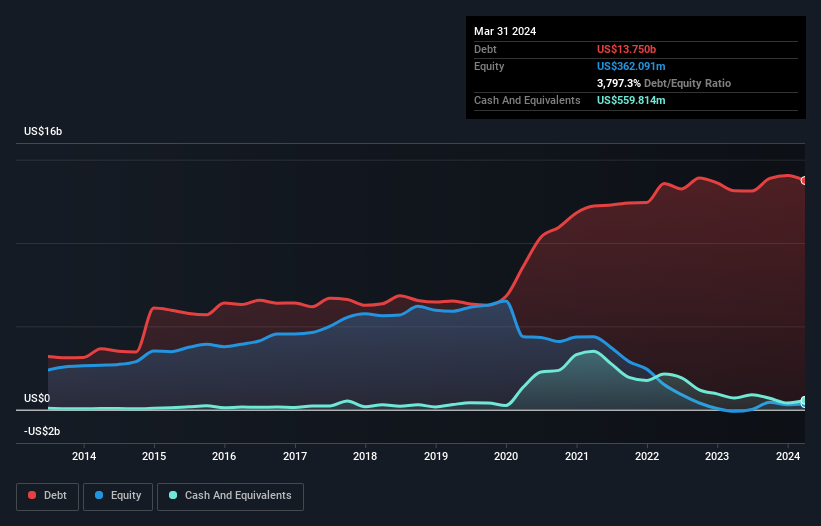- United States
- /
- Hospitality
- /
- NYSE:NCLH
Here's Why Norwegian Cruise Line Holdings (NYSE:NCLH) Is Weighed Down By Its Debt Load

The external fund manager backed by Berkshire Hathaway's Charlie Munger, Li Lu, makes no bones about it when he says 'The biggest investment risk is not the volatility of prices, but whether you will suffer a permanent loss of capital.' So it seems the smart money knows that debt - which is usually involved in bankruptcies - is a very important factor, when you assess how risky a company is. We note that Norwegian Cruise Line Holdings Ltd. (NYSE:NCLH) does have debt on its balance sheet. But is this debt a concern to shareholders?
What Risk Does Debt Bring?
Generally speaking, debt only becomes a real problem when a company can't easily pay it off, either by raising capital or with its own cash flow. Part and parcel of capitalism is the process of 'creative destruction' where failed businesses are mercilessly liquidated by their bankers. However, a more usual (but still expensive) situation is where a company must dilute shareholders at a cheap share price simply to get debt under control. Of course, plenty of companies use debt to fund growth, without any negative consequences. When we think about a company's use of debt, we first look at cash and debt together.
View our latest analysis for Norwegian Cruise Line Holdings
What Is Norwegian Cruise Line Holdings's Net Debt?
You can click the graphic below for the historical numbers, but it shows that as of March 2024 Norwegian Cruise Line Holdings had US$13.7b of debt, an increase on US$13.1b, over one year. On the flip side, it has US$559.8m in cash leading to net debt of about US$13.2b.

A Look At Norwegian Cruise Line Holdings' Liabilities
The latest balance sheet data shows that Norwegian Cruise Line Holdings had liabilities of US$6.60b due within a year, and liabilities of US$12.9b falling due after that. On the other hand, it had cash of US$559.8m and US$282.3m worth of receivables due within a year. So it has liabilities totalling US$18.6b more than its cash and near-term receivables, combined.
The deficiency here weighs heavily on the US$6.86b company itself, as if a child were struggling under the weight of an enormous back-pack full of books, his sports gear, and a trumpet. So we'd watch its balance sheet closely, without a doubt. After all, Norwegian Cruise Line Holdings would likely require a major re-capitalisation if it had to pay its creditors today.
In order to size up a company's debt relative to its earnings, we calculate its net debt divided by its earnings before interest, tax, depreciation, and amortization (EBITDA) and its earnings before interest and tax (EBIT) divided by its interest expense (its interest cover). Thus we consider debt relative to earnings both with and without depreciation and amortization expenses.
Weak interest cover of 1.5 times and a disturbingly high net debt to EBITDA ratio of 6.4 hit our confidence in Norwegian Cruise Line Holdings like a one-two punch to the gut. The debt burden here is substantial. However, the silver lining was that Norwegian Cruise Line Holdings achieved a positive EBIT of US$1.1b in the last twelve months, an improvement on the prior year's loss. The balance sheet is clearly the area to focus on when you are analysing debt. But ultimately the future profitability of the business will decide if Norwegian Cruise Line Holdings can strengthen its balance sheet over time. So if you want to see what the professionals think, you might find this free report on analyst profit forecasts to be interesting.
Finally, a company can only pay off debt with cold hard cash, not accounting profits. So it is important to check how much of its earnings before interest and tax (EBIT) converts to actual free cash flow. Over the last year, Norwegian Cruise Line Holdings saw substantial negative free cash flow, in total. While investors are no doubt expecting a reversal of that situation in due course, it clearly does mean its use of debt is more risky.
Our View
On the face of it, Norwegian Cruise Line Holdings's conversion of EBIT to free cash flow left us tentative about the stock, and its level of total liabilities was no more enticing than the one empty restaurant on the busiest night of the year. But at least its EBIT growth rate is not so bad. Taking into account all the aforementioned factors, it looks like Norwegian Cruise Line Holdings has too much debt. That sort of riskiness is ok for some, but it certainly doesn't float our boat. The balance sheet is clearly the area to focus on when you are analysing debt. However, not all investment risk resides within the balance sheet - far from it. To that end, you should learn about the 2 warning signs we've spotted with Norwegian Cruise Line Holdings (including 1 which doesn't sit too well with us) .
When all is said and done, sometimes its easier to focus on companies that don't even need debt. Readers can access a list of growth stocks with zero net debt 100% free, right now.
Valuation is complex, but we're here to simplify it.
Discover if Norwegian Cruise Line Holdings might be undervalued or overvalued with our detailed analysis, featuring fair value estimates, potential risks, dividends, insider trades, and its financial condition.
Access Free AnalysisHave feedback on this article? Concerned about the content? Get in touch with us directly. Alternatively, email editorial-team (at) simplywallst.com.
This article by Simply Wall St is general in nature. We provide commentary based on historical data and analyst forecasts only using an unbiased methodology and our articles are not intended to be financial advice. It does not constitute a recommendation to buy or sell any stock, and does not take account of your objectives, or your financial situation. We aim to bring you long-term focused analysis driven by fundamental data. Note that our analysis may not factor in the latest price-sensitive company announcements or qualitative material. Simply Wall St has no position in any stocks mentioned.
About NYSE:NCLH
Norwegian Cruise Line Holdings
Operates as a cruise company in North America, Europe, the Asia-Pacific, and internationally.
Very undervalued with reasonable growth potential.
Similar Companies
Market Insights
Community Narratives




